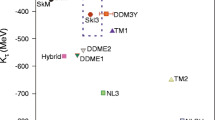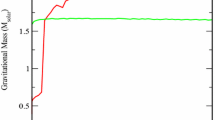Abstract
The potential energy of a nuclide is enhanced by about 10 MeV per nucleon from the repulsion between like nucleons, and diminished by about 20 MeV per nucleon from the attraction between unlike nucleons. Nuclear stability results mostly from the interplay of these opposing forces, plus Coulomb repulsion of positive charges. Whereas fusion may be the primary mechanism by which first generation stars produce energy, repulsion between like nucleons may cause neutron emission from the collapsed core (neutron star) produced in a terminal supernova explosion and initiate luminosity in second generation stars that accrete on such objects. As noted earlier [1], the scarcity of solar neutrinos, the enrichment of light isotopes in the solar wind, and the presence of abundant short-lived nuclides and interlinked chemical and isotopic heterogeneities in the early solar system might also be explained if the Sun formed in this manner.
Similar content being viewed by others
REFERENCES
O. Manuel (2000). In Origin of Elements in the Solar System:Implications of Post-1957 Observation (Kluwer Academic/Plenum Publishers, New York, NY) Proceedings of the ACS Symposium organized by Glenn T. Seaborg and Oliver K. Manuel, pp. 589-643. See web page at http://www.wkap.nl/book.htm/0-306-46562-0.
W. D. Harkins (1917). J. Am. Chem. Soc., 39, 856-879.
H. H. Payne (1926). “Stellar atmospheres,” Harvard Observatory Monograph, no. 1 (Harvard University, Cambridge, MA) 215 pp.
H. N. Russell (1929). Ap. J., 70, 11-82.
Fred Hoyle (1994). Home is where the wind blows. (University Science Books, Mill Valley, CA) pp. 152-154.
Edward Teller (1987). Better a shield than a sword. (Macmillian, New York, NY) pp. 257.
The Lunar Sample Preliminary Examination Team (1969). Science, 165, 1211-1227.
F. Begemann (1980). Rep. Prog. Phys., 43, 1309-1356.
J. H. Reynolds (1960). Phys. Rev. Lett., 4, 8-10.
J. H. Reynolds (1960). Phys. Rev. Lett., 4, 351-354.
D. D. Clayton (1975). Ap. J., 199, 765-769.
A. G. W. Cameron and J. W. Truran (1977). Icarus, 30, 447-461.
O. K. Manuel and D. D. Sabu (1975). Trans. Missouri Acad. Sci., 9, 104-122; Science 195, 208-209, (1977).
O. K. Manuel and G. Hwaung (1983). Meteoritics, 18, 209-222.
O. Manuel, C. Bolon, M. Zhong, and P. Jangam (2001). Abstract 1041, Lunar Planetary Science Conference XXXII, LPI Contribution No. 1080, ISSN No. 0161-5297.
J. K. Tuli (2000). Nuclear Wallet Cards, 6th Ed. (Upton, NY: National Nuclear Data Center, Brookhaven National Lab) pp. 74.
O. Manuel, C. Bolon, M. Zhong, and P. Jangam (2000). “The Sun's origin, composition and source of energy,” Progress report to FCR, Inc. http://www.umr.edu/,om/report to fcr/ report to fcr1.htm (December 25, 2000).
O. Manuel, C. Bolon, and M. Zhong (2001). J. Radioanal. Nucl. Chem. (in press).
E. M. Burbidge, G. R. Burbidge, W. A. Fowler, and F. Hoyle (1957). Rev. Mod. Phys., 29, 547-650.
Author information
Authors and Affiliations
Rights and permissions
About this article
Cite this article
Manuel, O., Bolon, C., Katragada, A. et al. Attraction and Repulsion of Nucleons: Sources of Stellar Energy. Journal of Fusion Energy 19, 93–98 (2000). https://doi.org/10.1023/A:1012290028638
Issue Date:
DOI: https://doi.org/10.1023/A:1012290028638




